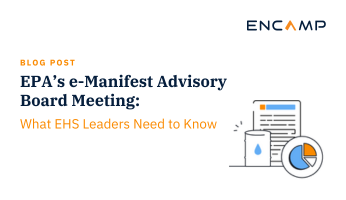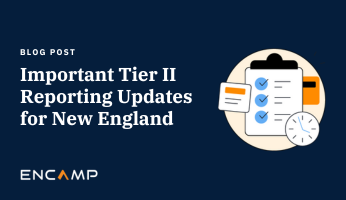As new regulations within the manufacturing sector pop up, it can seem a never-ending game of compliance “wack-a-mole”. Sometimes agencies make changes to existing regulations or add new rules; other times compliance issues are identified during site audits or by EHS program leaders. But whichever the case, managing the regulatory updates required at a site can be daunting. When modifications to your site’s environmental programs are required, utilize the comprehensive checklist below to ensure that you are setting up your site for success and ensuring compliance.
1. Complete a detailed regulatory review
-
- Revisit the regulatory language to ensure a thorough understanding of the requirements.
- Sometimes the language is not clear. If you have counterparts at other facilities within your company, discuss with them to ensure alignment.
- Did you know?💡 Encamp has a team of compliance experts that are here to help!
2. Get other stakeholders on board
-
- Once you have a clear understanding of what the regulations require, be sure to involve other departments at your site (e.g. maintenance, operations) right away.
- You can’t ensure compliance on your own! Input from other stakeholders who are more familiar with the equipment and operation is invaluable and will allow you to consider some aspects that you otherwise wouldn’t have thought of, such as capabilities of the instrumentation and control systems that may help to improve compliance.
3. Follow a management of change process
-
- Following a management of change process will ensure that nothing is missed. Of course you know that you need to establish a plan for compliance such as updating your compliance tracking tool or using a management system to add a recurring task for a new reporting requirement. But there are other things that will need to be done that the change process will help you to identify (e.g. Do preventative maintenance tasks for your instrumentation/equipment need to be added/updated? Does an operator round need to be added to better monitor a particular piece of equipment or chemical handling area?).
- Review the change in detail with all applicable departments at your site and assign action items as needed.
- Be sure to document this process, so all stakeholders can see progress.
4. Consider how others can view compliance information
-
- Oftentimes, EHS professionals are the only ones at a site who view and track compliance data. This does not allow others to help to improve compliance, as they cannot assist in monitoring and proactively adjusting the operation to avoid violations.
- Revisiting and making changes to a program presents a great opportunity to make improvements to it! These changes often require updates to site plans/procedures, management of change, etc., so it is beneficial to complete multiple updates at once.
- Think about what tools you can implement at your site to allow others to help. Can you create a pre-alarm on your distributed control system at a setpoint prior to the environmental limit, with guidance for the operator on how to avoid a violation? Can you create an electronic database for your QA/QC forms, and provide electronic forms with required fields for maintenance personnel to complete in the field via electronic devices? Implement systems for environmental compliance that cannot fail!
- Did you know?💡 Encamp has capabilities that allow for simple data entry, data manipulation, and data sharing.
5. Spread the word
-
- Training and communication is key! Set up your facility for success by ensuring that other departments know about the coming changes. Think bulletins, lunch and learns, information sessions, web-based trainings, etc. When possible, provide one-on-one training with the ‘field’ employees who are operating and maintaining the equipment, as this is very effective. Don’t forget contractors who may be affected by the change. In these trainings/communications, be sure to include the why behind the coming change and specific guidance for how each work group can help.
- Be sure to consider whether the regulatory changes need to be communicated to management at your site. They may need to know so that they can ensure their personnel are aware and doing their part to help the site maintain compliance.
6. Update documentation
-
- Consider whether the change requires updates to site plans, procedures, or guidelines (e.g. chemical storage guidelines, spill plans, startup/shutdown procedures, EHS program leader job aides). Also consider whether any process safety information (e.g. SDSs) needs to be updated. Ensure that your documentation is up-to-date and reflects current processes.
Whether the required change is big or small, it helps to get others involved. While completing the change, follow a management of change process to ensure that all necessary considerations are made. Think ahead; Will your current systems allow your site to maintain compliance, or can you improve them? Communicate the change to all affected personnel at your site and prepare them well. And lastly, update all relevant documentation to ensure your compliance programs are auditable. Looking to ensure your company is in compliance? Our experts can help. Encamp solves the complexity of environmental compliance with high-tech solutions and high-touch support. We help enterprises transform compliance programs and human processes into a technology-driven system that lays the foundation for accurate and ongoing environmental compliance. Request a demo to learn more.
Crystal Kukic
As a Compliance Program Manager at Encamp, Crystal provides regulatory expertise and aids in the further development of the Encamp product. Prior to Encamp, she accrued over 8 years of technical experience at Marathon Petroleum Corporation while in multiple different workgroups including process engineering, process controls, environmental services, and process safety. As an Environmental Professional, she led a variety of air programs and spent a great deal of time on work to revamp existing systems and processes to significantly improve site compliance. She enjoys studying the regulations and finding creative ways to ensure compliance in an efficient manner. Crystal is a graduate of Wayne State University, where she earned her B.S. in Chemical Engineering.



